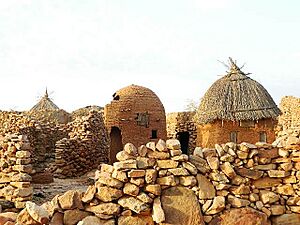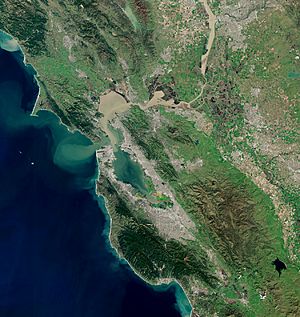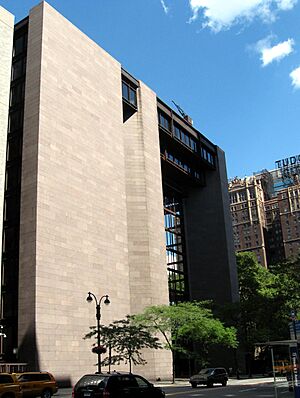Carl Anthony facts for kids
Carl Anthony (born February 8, 1939) is a leader who works for fairness in society and for a healthy environment. He is an American architect, a planner for communities, and an author. He started Urban Habitat, an organization that helped the environmental movement deal with issues of race and social class. He also co-founded Breakthrough Communities. This project helps build diverse leadership for sustainable communities across California and the nation. Carl Anthony was also the former President of the Earth Island Institute.
Carl Anthony was born in 1939 in Philadelphia, Pennsylvania. His neighborhood, Kingsessing, was mostly African American. His parents, Lewis and Mildred Anthony, sent him and his older brother Lewie to an integrated elementary school. This school, B.B. Comegys, had only about a dozen African American students out of 300. It was different from the neighborhood school, Alexander Wilson, which was very close to their home.
Later, Carl attended Dobbins Vocational School. He studied carpentry and cabinet-making there. His teachers were impressed by his drawings. They suggested he move to architectural drafting. This is where he really developed his interest in architecture.
Contents
Carl Anthony's Education and Early Work
Carl Anthony earned a degree in architecture from Columbia University in 1969. He wanted to understand how to design buildings and plan projects. After graduating, he received a special grant called the William Kinne Fellowship. This grant allowed students to travel and learn more.
Anthony traveled to West Africa. He visited traditional towns and villages. He studied how people used the few resources they had to build their homes and shape their surroundings. He returned from Africa in 1971. He then became an assistant professor at California-Berkeley College of Natural Resources. He taught there for ten years. After leaving Berkeley, Anthony developed the Urban Habitat program.
Urban Habitat: Helping Communities (1989–2000)
Carl Anthony led the Earth Island Institute from 1991 to 1998. In 1996, he was a special guest at Harvard University's Institute of Politics. With his friend Luke Cole, Anthony started a magazine called the Race, Poverty, and the Environmental Journal. This was the first magazine in the United States focused on environmental justice.
In 1989, Anthony founded the Urban Habitat Program. He worked with David Bower and Karl Linn. The program's goal was to combine education with advocacy. They also built partnerships to promote environmental and social justice. They focused on low-income communities in the San Francisco Bay Area. Anthony was the Executive Director until 2000.
Urban Habitat worked on many projects. They helped people of color become environmental leaders. They challenged environmental problems through the lens of race and poverty. Here are some examples of their work:
- Bay Area Justice and Sustainability Project: This project created a plan for fairness and sustainability in the region. It looked at how planning policies led to problems in inner cities.
- Leadership Institute for Sustainable Communities: This program trained leaders. It taught them about land use policies and practices.
- Transportation and Environmental Justice Project: This project pushed for changes in transportation planning. It aimed to meet the transit needs of low-income communities.
- Brownfields Community Leadership Project: This project worked with leaders in low-income communities. It made sure that redeveloping old industrial sites (Brownfields) met their needs.
- Hunter's Point Environmental Health Project: This project trained residents and leaders in environmental health. It focused on justice issues and laws in their community.
- Parks and Open Space for All People: This project worked to improve San Francisco's park system. It focused on the needs of low-income communities. It made sure everyone could use the parks.
Ford Foundation Work (2001–2008)
In 2001, Carl Anthony was chosen to lead the Sustainable Metropolitan Communities Initiative (SMCI). This program helped disadvantaged communities. The Ford Foundation invested in community development groups. They focused on African American neighborhoods with lower incomes.
Anthony worked to reduce poverty in the United States. He also promoted saving natural resources. He created ways for groups to work together. He built a national network for communities to learn from each other. In 2004, Carl Anthony became the director of the Ford Foundation’s Community Resources Development Union. He left this role in 2008.
Breakthrough Communities (2008–Present)
In 2008, Carl Anthony co-founded Breakthrough Communities. This project is part of Earth House Center. It works for fairness in regions and for environmental and climate justice. Anthony is currently the co-director of this project. He also started Six Wins, an initiative in the Bay Area. This initiative works to reduce carbon dioxide emissions.
Carl Anthony's Book: The Earth, the City, and the Hidden Narrative of Race (2017)
In 2017, Carl Anthony wrote his memoir, The Earth, the City, and the Hidden Narrative of Race. A memoir is a book about a person's life experiences. This book combines his personal stories with history and political ideas. Anthony shares his experiences as an architect, a planner, an environmentalist, and a Black American.
He connects his life to urban history, racial justice, and the challenge of healing the environment. The book includes stories from his childhood in Philadelphia after World War II. It also covers his time as a student and civil rights activist in the 1960s. He writes about studying West African architecture and culture. He also shares how he became a leader in environmental justice. The book focuses on architecture, farming, Black towns, and city housing. It also shares his research on the African Slave trade, the Civil Rights movement, environmental damage, and community groups.
Boards, Commissions, and Awards
Carl Anthony has received many honors and served on important groups:
- 1991–1997: President, Earth Island Institute
- 1991–1993: President, City of Berkeley, Planning Commission
- 1993–1995: Founder and President, EDGE, Alliance of Ethnic and Environmental Organizations of California
- 1993–1996: Chair and Principal Administrative Officer, East Bay Conversion and Reinvestment Commission
- 1995: Honoree, KQED Black History Month
- 1995: Humanitarian Award, San Francisco Foundation
- 1996: Fellow, John F. Kennedy School of Government, Harvard University
- 1996–1997: President, Board of Directors, Alameda Center for Environmental Technology
- 1997: Josephine and Frank Duveneck Humanitarian Award
- 1999–2001: Co-chair, Community Capital Initiative of the Bay Area Alliance for Sustainable Development
- 2014: Certificate of Special Congressional Recognition by Congresswoman Barbara Lee
- 2015: Community Engagement Award, UC Davis
- 2015: Trailblazer Award from the Sierra Club





